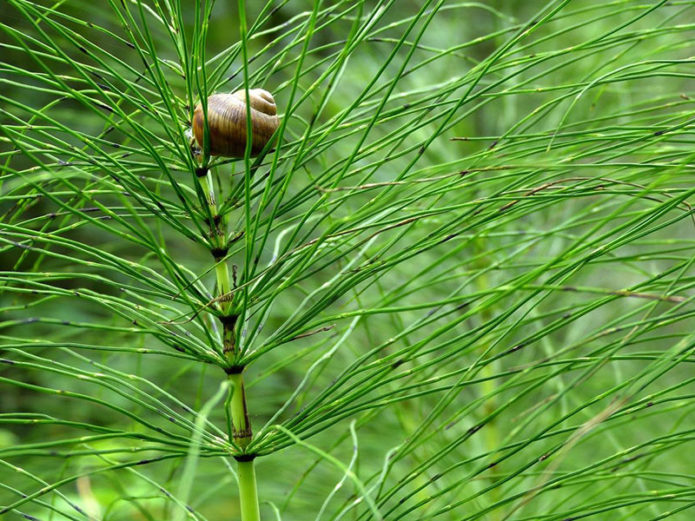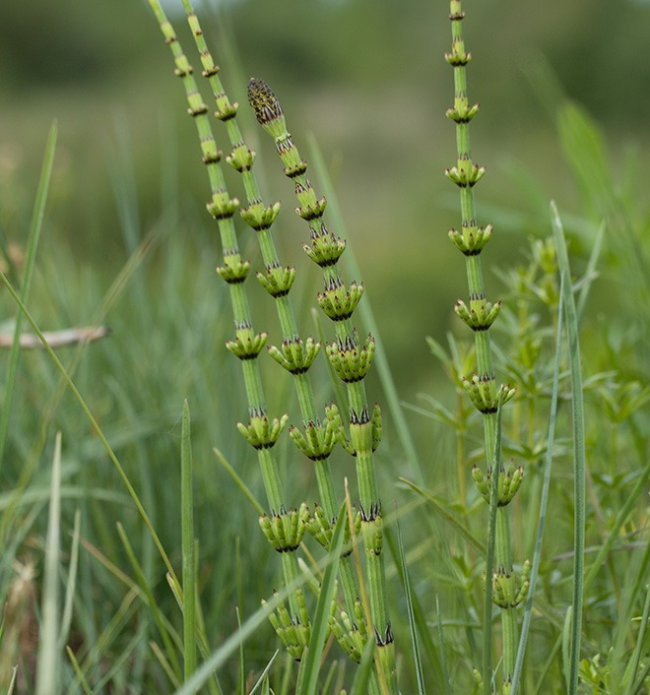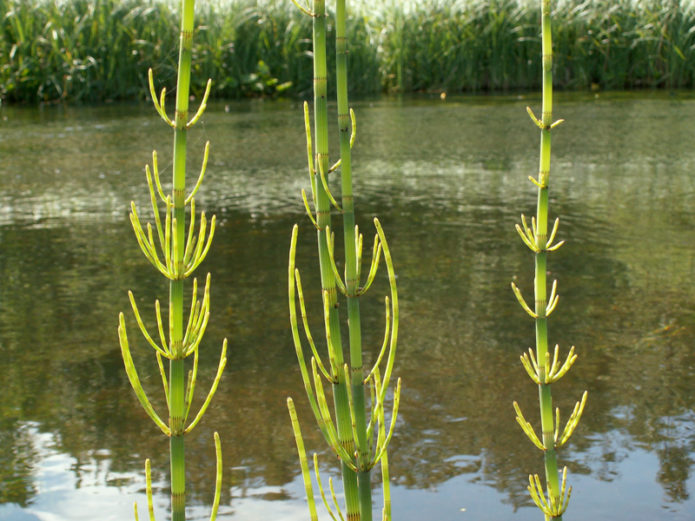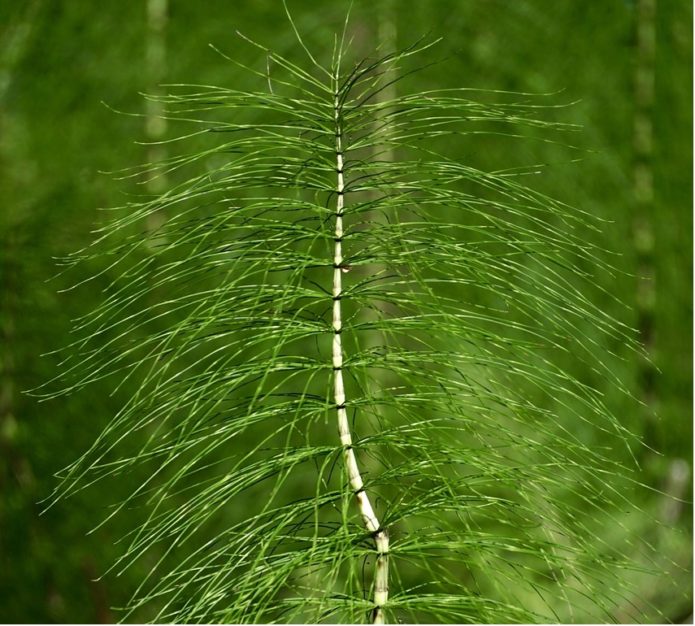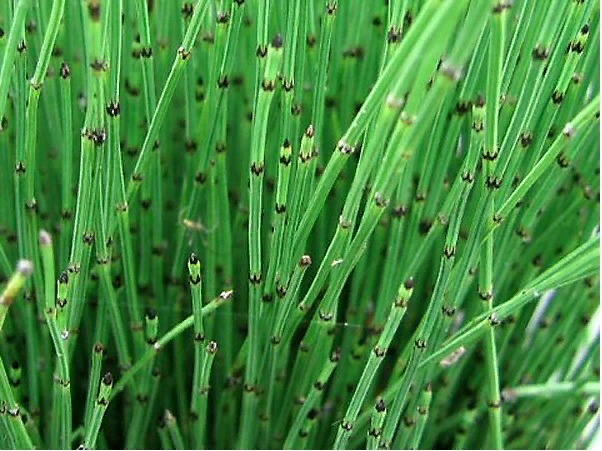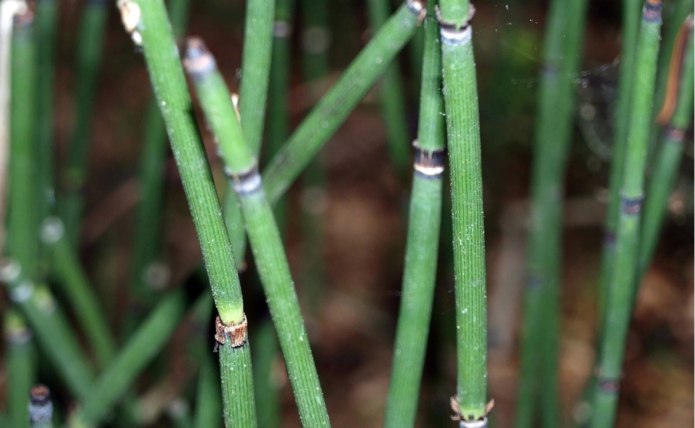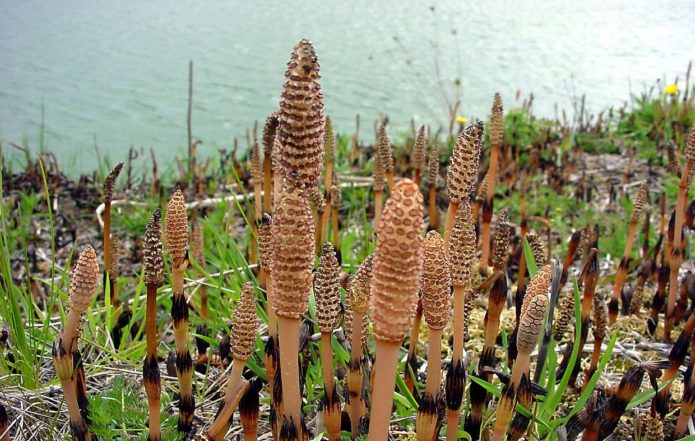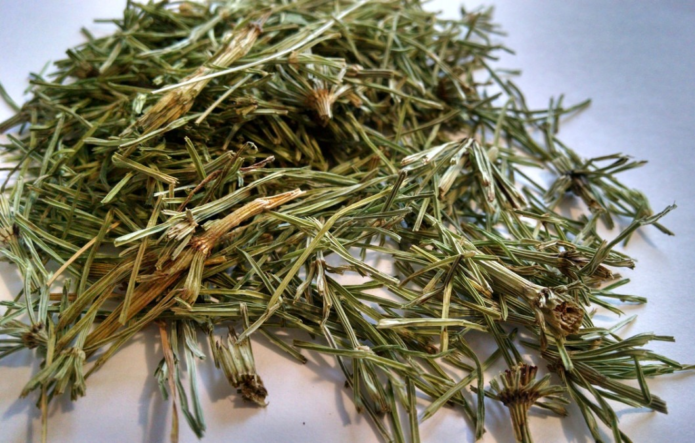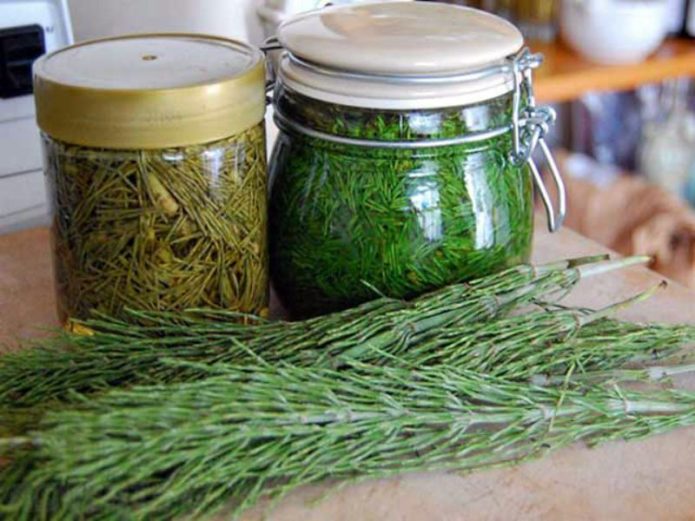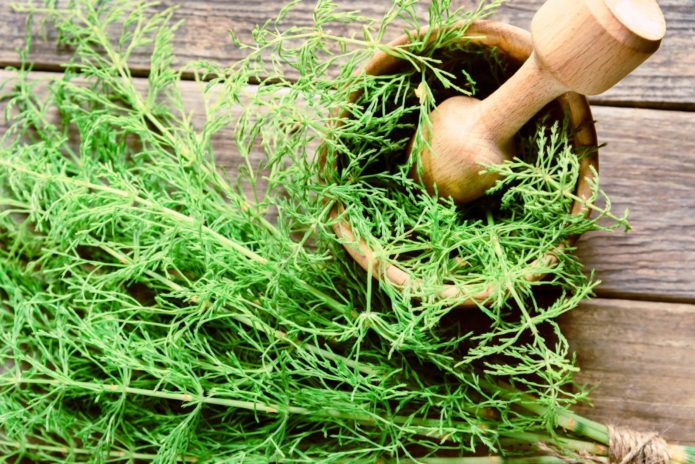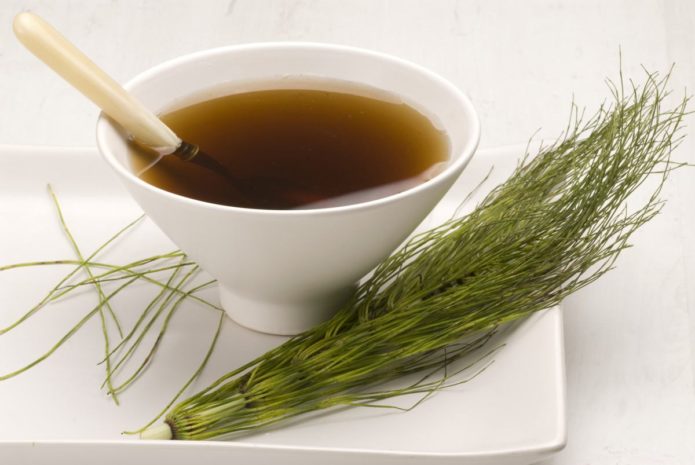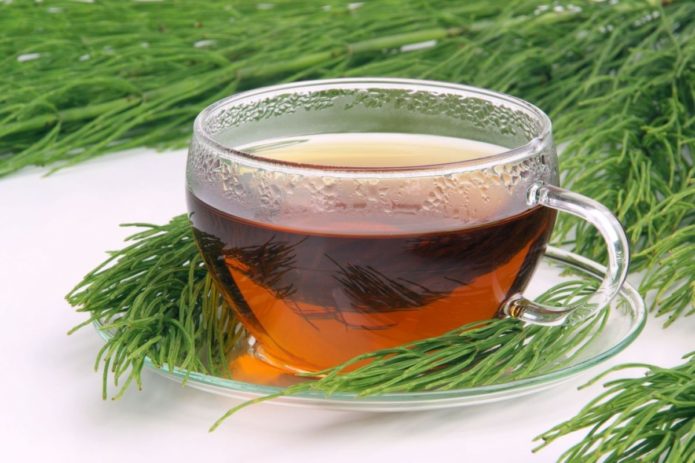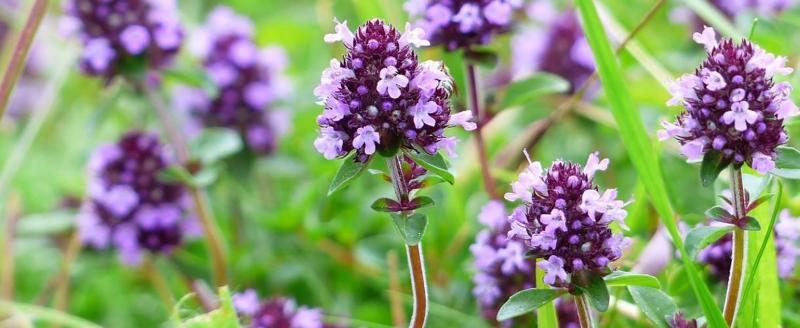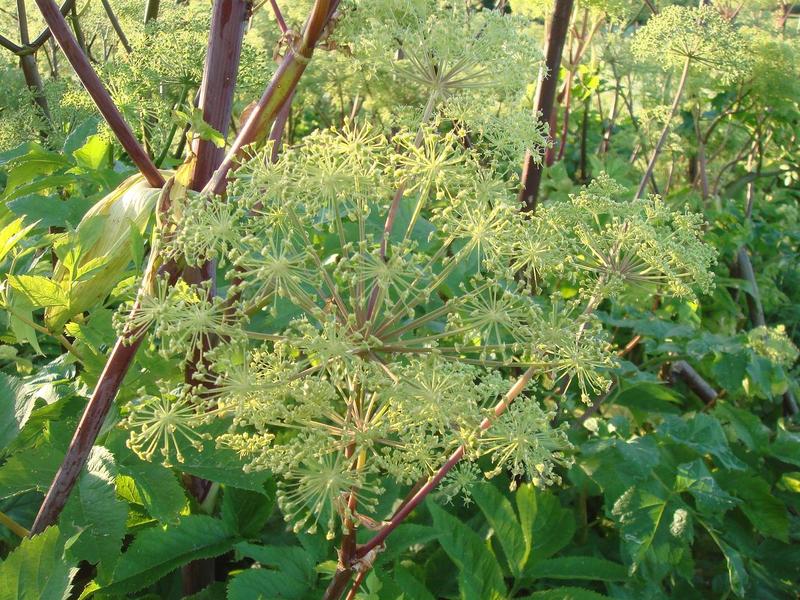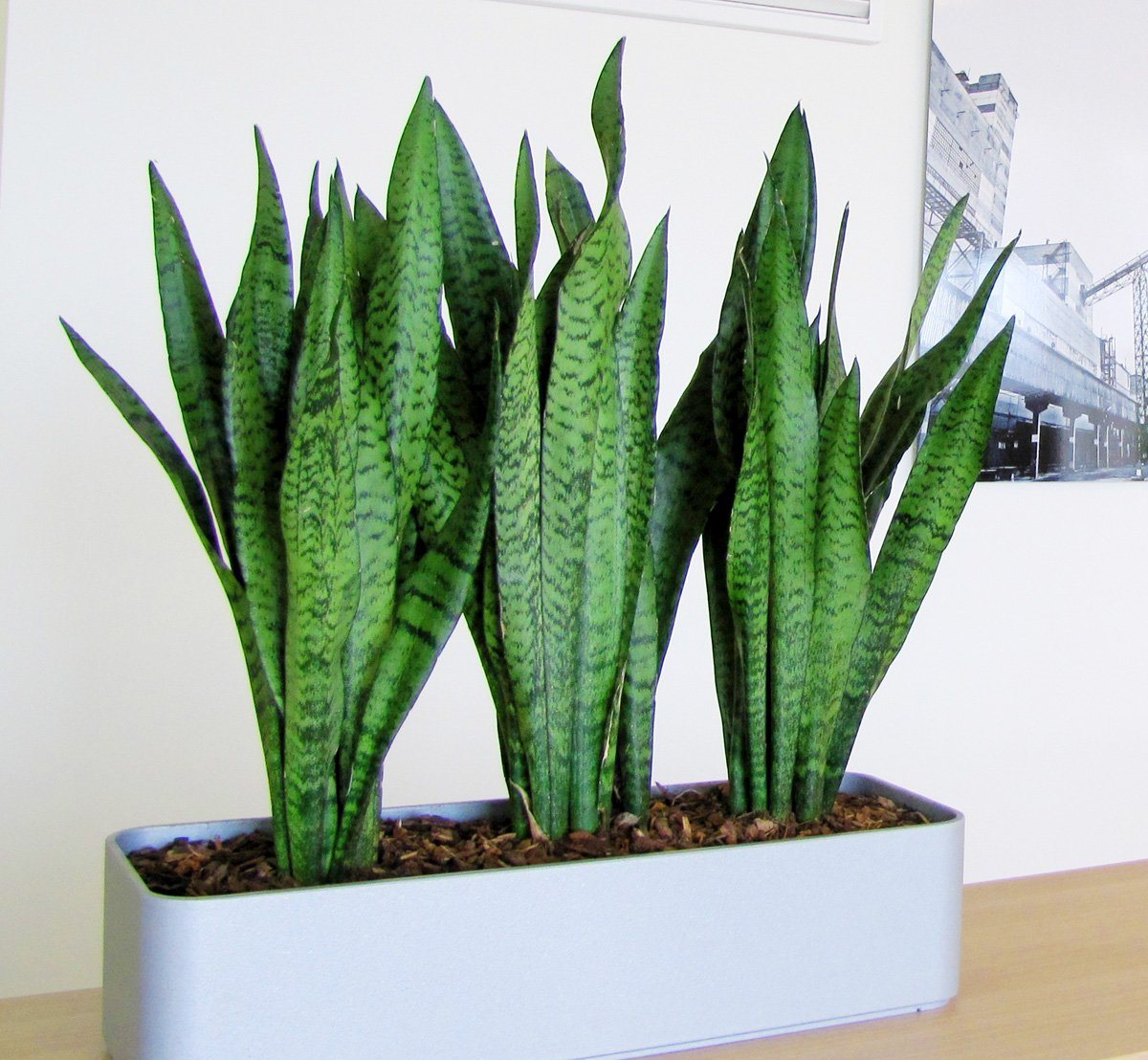The plant is known primarily as an annoying weed that annoys summer residents. But few people know that horsetail has many medicinal properties. In past centuries, village healers used it for diseases of the skin and digestive system, as an analgesic and hemostatic agent. Today the plant is used in both scientific and home medicine.
Content
Description and photo of the plant
This perennial herb has black underground and partly aerial jointed roots with nut-shaped tubers. They can be eaten baked and taste like boiled potatoes.
In summer, the grass resembles a Christmas tree, and in spring it resembles a mushroom. Outwardly, it is similar to a horse's tail, hence the most common name - ponytail. But there are also other names:
- field tree;
- panicle;
- tin grass;
- mop grass;
- pusher;
- little dogs;
- sucker.
Differences from other species
The lateral branches of the summer grass have medicinal properties. The plant is included in the State Register of Medicines of the Russian Federation. There are also other types. They differ in appearance and have almost no value:
- swamp - also used for medical purposes, but not so popular;
- river - much larger than other species, grows up to 150 cm, rarely has branches, and if they are, they are always smooth and without branches;
- meadow - about 50 cm high, its branches are protruding or curved downward, unbranched;
- forest - has highly branched branches, grows in damp and dark places;
- giant (large) - grows up to 100 cm;
- motley - differs from its counterparts in the complete absence of branches, a plant of small height - up to 30 cm;
- whorled - grows up to 100 cm, branches directed upwards, with small tubercles;
- winter (wintering) - it grows up to 125 cm, branches are rare, and if there are, then very short;
- poisonous - it is better to bypass the plant, its branches are directed downward, therefore it is easy to distinguish it from a useful species.
The benefits of herbs
Due to its medicinal properties, the ponytail has an excellent effect on the human body, has a beneficial effect on its various systems.
Horsetail: medicinal properties
The healing qualities of this herb include:
- antimicrobial and anthelmintic (destroys parasites that live in the gastrointestinal tract);
- anti-inflammatory (soothes the skin);
- hemostatic;
- cleansing (removes toxic substances and toxins);
- diuretic (removes fluid from the body, reduces the amount of protein in the urine);
- wound healing (helps to quickly restore the skin after damage);
- expectorant (promotes liquefaction and removal of phlegm);
- astringent (eliminates indigestion, hemoptysis);
- improved metabolism (removes excess cholesterol, facilitates the absorption of calcium).
The plant is a source of vitamin C, calcium, potassium, iron, copper, magnesium, zinc.
Indications for use
The herb is recommended for the following health problems:
- diseases of the genitourinary system;
- metabolic disease;
- diseases of the skin and hair;
- diseases of the musculoskeletal system;
- hypertension;
- lung disease;
- diseases of the digestive system;
- decreased immunity;
- diseases of the cardiovascular system;
- eye diseases;
- violation of the nervous system;
- swelling;
- colds.
Is a ponytail safe
This herb is not shown to everyone. It has features that can be harmful. A doctor's consultation is required for all people wishing to undergo a course of plant treatment.
Contraindications
Horse tail and preparations based on it are contraindicated:
- children under 3 years old;
- pregnant and lactating women;
- with severe forms of diseases of the digestive and excretory systems;
- diabetics;
- with hyperfunction of the thyroid gland;
- with tuberculosis;
- with individual intolerance.
Restrictions on use
The ponytail is a poisonous plant. The dosage of the drug must comply with the instructions for use, otherwise the body will lose potassium and vitamin B1.
Side effects
The following body reactions are possible:
- nausea;
- vomiting;
- diarrhea;
- heaviness in the abdomen.
These symptoms mean that the medicine is not suitable, so it is worth stopping use.
Home remedy recipes: step by step instructions
The plant is used dry and fresh, applied internally and externally.
Water infusion
To prepare this form of a remedy, it is better not to use metal dishes, but to take enamel or ceramic ones.
For diseases of the kidneys and bladder
Preparation:
- Put 300 g of dry herbs in a bowl, pour 6 liters of boiling water.
- Insist until it cools completely.
- Strain through cheesecloth.
Take 2-3 glasses a day for a week.
Bad breath
Preparation:
- Pour 2 tbsp into 2 cups of water. l. herbs.
- Boil.
- Insist 10 hours.
- Strain.
Rinse your mouth with infusion 2 times a day.
With conjunctivitis
The medicinal properties of the herb are used to prepare a remedy that relieves a person's condition with inflammation of the eye mucosa:
- Mix fresh cornflower and ponytail in a 1: 1 ratio.
- Pour boiling water over.
- Withstand a day under the lid.
Flush eyes in the morning and evening.
With hypertension
Preparation:
- 2 tbsp. l. horse tail, 1 tbsp. l. hawthorn (flowers and berries) pour 200 ml of boiling water.
- Insist 1 tsp.
Divide the resulting product into three parts and drink it a day.
Alcohol tincture
The cauda equina in this dosage form is used to stop internal bleeding, improve metabolism, treat tumors, and also for problems with the scalp.
Tincture preparation:
- Pour 1 tbsp into 1 liter of white wine (or vodka). l. herbs.
- Remove to a dark place for a week.
Drink the prepared medicine before breakfast, 2 tbsp. l. every day for 2-3 weeks.
With oily scalp and often dirty hair, the tincture is added to the shampoo (1 tbsp. L. Per 100 g of the product) and the hair is washed in the usual way.
Decoction
Ponytail decoctions are taken orally.
With edema
It is effective in treating edema caused by heart and kidney failure. You can prepare it according to any of the recipes below.
Option one:
- Pour 20 g of dry raw materials into water (200 ml).
- Boil, let it brew for half an hour.
Drink 3-4 times a day for 1 tbsp. l. spoon.
Option two:
- Pour 50 g of dry herb into 4 glasses of water.
- As it boils, remove from heat.
- Cover with a lid for 10 minutes.
- Keep in a warm place for half an hour.
- Strain.
Drink the broth in a glass three times a day before meals.
For sleep disturbances and irritability
The broth helps to restore normal sleep, calms the nervous system.
Preparation:
- Boil 2 liters of water.
- Pour dry herbs: 2 tbsp. l. hawthorn flowers, 1 tbsp. l. horsetail and 3 tsp. bird highlander.
- Darken for 15 minutes. over low heat.
- Strain.
Drink 50 ml 3 times a day before meals.
With bronchitis
Preparation:
- Pour 20 g of grass into 250 ml of milk.
- Boil.
- Cook for 20 minutes. over medium heat.
Take the broth hot in a glass 2 times a day before meals.
With menstrual pain
Preparation:
- Put 1 tbsp in 200 ml of boiling water. l. herbs.
- Boil.
- Boil for 2 minutes, then remove from heat.
Drink 50 ml 4 times a day.
Extract
A liquid extract of the plant is taken for baldness. Ready-made briquettes can be bought at the pharmacy.
Preparation:
- Pour ½ briquette wedges with a glass of cold water,
- Boil for half an hour.
- Refrigerate.
- Strain.
With massaging movements, the medicinal extract is applied to the scalp - ½ tsp. 3-4 times a day. Rub it with your hands until it is completely absorbed.
Ointment
To treat scratches, purulent wounds and other damage to the skin, a horse's tail ointment is used.
Preparation:
- Powder dry grass.
- Mix it with 4 tsp. lard or petroleum jelly.
- Treat problem areas.
The ointment has beneficial properties - it disinfects damage and promotes skin regeneration.
Tea
Tea is recommended for painful urination and cystitis.
Preparation:
- Mix dry chamomile flowers and horse tail grass equally.
- Take 1 tsp. mixtures.
- Brew with a glass of boiling water.
- Insist 10 minutes.
Drink 3 glasses a day.
Compresses
They are used to treat rheumatism, joint diseases, and acne on the skin.
Preparation:
- Pour 3 tbsp into 500 ml of cold water. l. herbs.
- Leave to infuse for a day.
- Soak a bandage, gauze or cotton wool with tincture.
Apply as lotions and compresses.
Juice
A ponytail in the form of juice is recommended for use when:
- swelling;
- varicose veins;
- violation of immunity;
- bleeding and purulent wounds;
- frequent nosebleeds.
Preparation:
- Rinse fresh grass in clean water.
- Grind the raw material.
- Squeeze out the juice.
Inside, the juice is used 3 times a day for 2 tsp. Outwardly: sore spots are also treated three times a day. With the same frequency, the agent is instilled into the nose: 2 drops in each nostril.
Baths
Baths are useful for:
- circulatory disorders in the arms and legs;
- frostbite;
- low metabolism;
- rheumatism;
- joint diseases;
- increased sweating of the legs and arms.
Preparation:
- Pour 100 g of dry grass with one liter of boiling water.
- Insist half an hour.
- Strain.
Add the product to the water. Treatment course - 15 baths for a quarter of an hour every other day.
How to harvest and store grass
For self-preparation of potions, properly collected raw materials are needed. It is also important to comply with the storage conditions.
How to determine the quality of raw materials
Pay attention to some details when collecting the plant:
- the grass should be free of signs of damage and disease - spots, rot, insect damage, plaque;
- do not collect wet grass immediately after rain or wash it after collection - wet raw materials can rot;
- a healthy plant has a pleasant bright green color, fluffy branches.
Blank
For harvesting, clear, cool weather in the morning or evening is optimal. To get quality raw materials, consider the following recommendations:
- harvest time - summer, when the plant grows up to 20-30 cm;
- cut the stems about 10 cm from the soil layer;
- use pruning shears or scissors, as the plant can be damaged if you pick it off with your hands;
- sort through the collected grass and remove the yellowed branches;
- with natural drying, stir the grass to avoid decay - on the first day, do this at least three times;
- to speed up the process, use a dryer for fruits and vegetables - process raw materials at a temperature not exceeding 45 ° C for 6-10 hours;
- the finished product has a grayish color and a weak acidic taste.
The collection of herbs is carried out in ecologically clean areas, without roads and industrial facilities nearby. This is important as it absorbs harmful substances.
Storage rules
The harvested grass must be stored correctly:
- in a cool, dry and dark place;
- in bags of cotton or paper;
- up to 5 years.
Reviews
After suffering cystitis, the doctor recommended me to buy some herb or urological collection. To prevent cystitis, I brewed 2 filter bags in a glass, insisted for 30 minutes and drank half a glass 2 times a day. I drank the grass for about 3 months, then stopped, because I learned that I would become a mother. I will recommend horsetail as a prophylaxis for cystitis, since 3 months during its application and already 4 months after cystitis does not bother me.
... a wonderful herb for its usefulness. I was attracted, first of all, by the antitoxic effect, toxic substances are eliminated, including cholesterol, lead, mercury. It is used as a diuretic for various edema, including heart and circulatory insufficiency, and the diuretic effect is very delicate - in any case, you will not have to run in search of a toilet.
For a long time, this weed plant simply plagued me in the country. It has a long root, multiplies quickly and grows quickly. I read about its healing qualities. However, somehow it was not necessary to apply them in practice. But then a big trouble happened to me. My hair began to thin out and fall out. I went to the doctors, I was prescribed treatment. Horsetail was prescribed to me for washing and rinsing hair, as well as raw material for preparing a medical hair mask. It holds the record for silicon content. And he, as you know, is responsible for the health of nails, bones, teeth and hair. I coped with my trouble. But now every summer I make blanks from it in order to use it for prevention.
Video: useful properties of the ponytail
Knowledge of the medicinal properties and contraindications of the plant, the features of the application and the rules for the self-preparation of medicinal products based on this herb are very important. They will help you to use wisely all the beneficial qualities of the horsetail and not harm your health.
